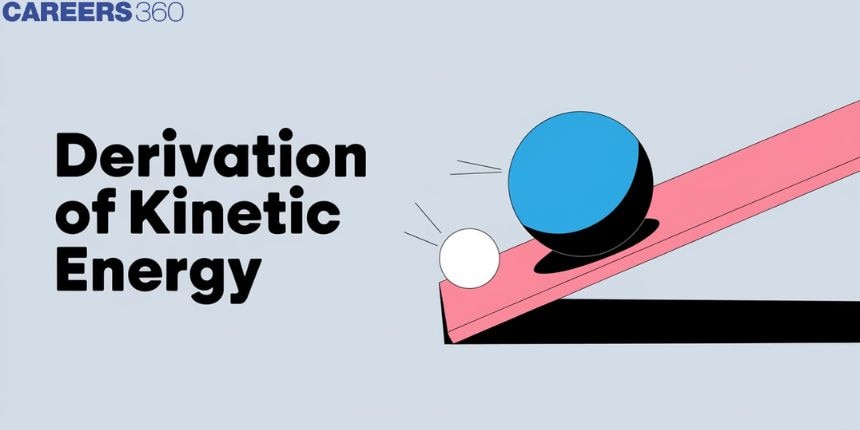Derivation of Kinetic Energy - Definition, Equation, Example, FAQs
Understanding kinetic energy and its derivation is necessary for students to get a complete understanding of motion and energy in Physics. This article clearly and simply explains how a moving body gains energy and how work done on it changes that energy. You will also understand the work-energy theorem, potential energy, and the difference between different forms of energy with simple examples. These topics are not only important for school exams but play a major role even for competitive exams like JEE Main, NEET, and other entrance tests, where questions on energy, work, and motion are very frequently asked.

Also read -
Definition of Kinetic Energy
Kinetic Energy: The kinetic energy of a moving body is the measure of work required to bring the body from rest to its present state of motion, or the work it can perform before coming to rest.
A body possesses kinetic energy due to its motion, and this energy depends on both the mass of the body and its velocity.
Derivation of Kinetic Energy (Using Constant Force)
Consider a body of mass $m$ initially at rest.
A constant force $\mathbf{F}$ acts on it, producing an acceleration a.
From Newton's Second Law:
$
a=\frac{F}{m}
$
Let the body attain a velocity $\mathbf{v}$ after moving through a distance $\mathbf{s}$.
Using the kinematic equation:
$
\begin{gathered}
v^2=2 a s=2\left(\frac{F}{m}\right) s \\
F \cdot s=\frac{1}{2} m v^2
\end{gathered}
$
The work done,
$
W=F \cdot s
$
This work is stored as kinetic energy $(\mathrm{K})$, therefore:
$
K=\frac{1}{2} m v^2
$
Kinetic Energy $=\frac{1}{2} \times$ mass $\times$ velocity ${ }^2$
This shows speed has a greater effect on kinetic energy compared to mass because velocity is squared.
- Unit: Joule
- Dimensional Formula: $\left[M L^2 T^{-2}\right]$
General Derivation of Kinetic Energy (Variable Force)
If a variable force $\mathbf{F}$ acts on a body of mass $\mathbf{m}$, the infinitesimal work done for a displacement ds is:
$
d W=\vec{F} \cdot d \vec{s}
$
Using Newton's law:
$
F=m a=m \frac{d v}{d t}
$
Substituting:
$
d W=\left(m \frac{d v}{d t}\right) d s=m v d v \quad\left(\because v=\frac{d s}{d t}\right)
$
Total work done from velocity 0 to v :
$
\begin{gathered}
W=\int_0^v m v d v \\
W=\frac{1}{2} m v^2
\end{gathered}
$
Thus,
$
K=\frac{1}{2} m v^2
$
Kinetic energy is a scalar quantity.
Derivation of Kinetic Energy (Class 9 Method)
A body of mass $\mathbf{m}$ moving with velocity $\mathbf{v}$ is brought to rest by a retarding force $\mathbf{F}$ over a distance $\mathbf{s}$.
Initial velocity $=\mathrm{v}$
Final velocity $=0$
Using kinematics:
$
0=v^2+2 a s
$
Since $\mathbf{a}$ is negative:
$
s=\frac{v^2}{2 a}
$
Work done by retarding force:
$
\begin{gathered}
W=F \cdot s=(m a) \cdot \frac{v^2}{2 a} \\
K E=\frac{1}{2} m v^2
\end{gathered}
$
Work-Energy Theorem
The work-energy theorem states:
The work done by a force on a body equals the change in the kinetic energy of the body.
If a body's velocity changes from $\mathbf{u}$ to $\mathbf{v}_{\text {, then: }}$
$
\begin{gathered}
W=\frac{1}{2} m v^2-\frac{1}{2} m u^2 \\
W=\Delta K
\end{gathered}
$
Thus,
$
W=\Delta K
$
Types of Kinetic Energy
- Thermal energy
- Radiant energy
- Sound energy
- Mechanical energy
- Electrical energy
All these are forms of kinetic energy.
Potential Energy
Potential energy is the energy possessed by a body due to its position or state of deformation.
Example: Water at a height possesses potential energy which can be used to rotate a turbine.
Also Read:
Potential Energy
Potential energy is the energy possessed by a body due to its position or state of deformation.
Example: Water at a height possesses potential energy which can be used to rotate a turbine.
Gravitational Potential Energy
If a body of mass $m$ is raised through a height $h$, work must be done against gravity.
$
W=m g h
$
This work is stored as:
$
U=m g h
$
If the body falls back, it can give back the same amount of work.
Also check-
- NCERT Exemplar Class 11th Physics Solutions
- NCERT Exemplar Class 12th Physics Solutions
- NCERT Exemplar Solutions for All Subjects
NCERT Physics Notes:
Frequently Asked Questions (FAQs)
We can derive the expression
K = 1/2mv²
The kinetic energy of a moving body is measured by the amount of work that has been done in bringing the body from rest position to its present position
Formula of kinetic energy K = 1/2mv²
The SI unit of kinetic energy is the joule.
The dimensional formula of the kinetic energy is [ML²T-²].
The formula of gravitational potential energy is
U = mgh